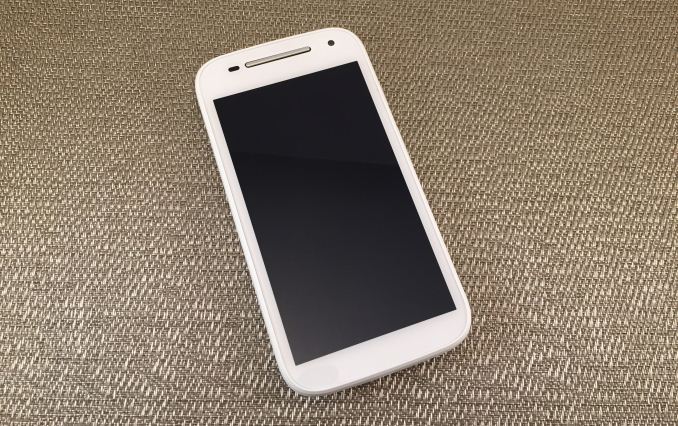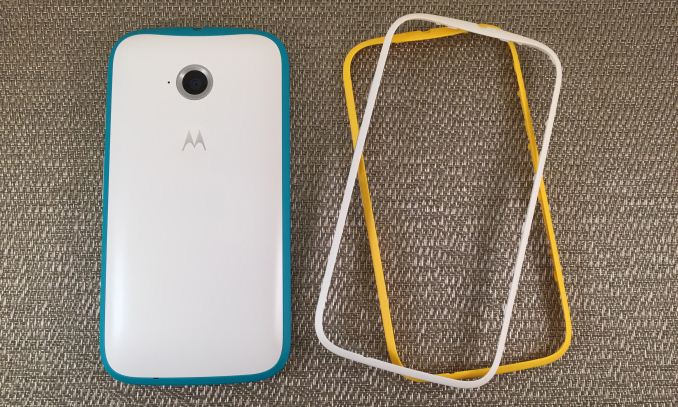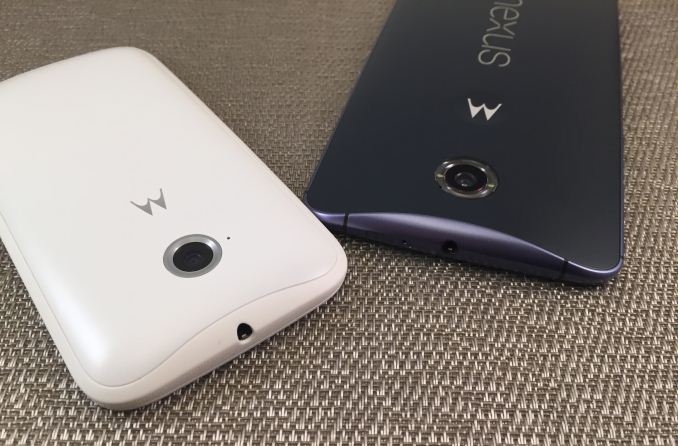The Moto E (2015) Review
by Brandon Chester on April 21, 2015 8:00 AM EST- Posted in
- Smartphones
- Motorola
- Mobile
- Moto E (2015)

During the past couple of years we've seen a dramatic shift in Motorola's strategy for competing in the smartphone market. As one of the earliest producers of Android devices, the company needed to let go of ideas and strategies from years that had since past. Producing exclusive devices for carriers like Verizon was no longer going to work with the iPhone finally freed from exclusivity on AT&T, and Motorola's hardware and software design had begun to show a great deal of age.
That brings us to today, at a point where Motorola has more or less found their new approach to making smartphones. It's a very simple and understandable approach. Consistency across the design of the hardware, consistency across the design of the software, and a yearly line of phones that can easily be divided into budget, mid-range, and flagship categories based on a single letter in their name. This review takes a look at the newest version of Motorola's budget device, the 2015 Moto E. Unfortunately, this year adds a bit of complexity to the simplicity of Motorola's smartphone line. Before getting into that, I've put the general specifications of the new Moto E below, with the original 2014 model as a point of comparison.
| Motorola Moto E (2015) (LTE model XT1527) |
Motorola Moto E (2015) (3G models) |
Motorola Moto E (2014) | |
| SoC | Qualcomm Snapdragon 410 (MSM8916) 4x Cortex A53 @ 1.2GHz Adreno 306 at 400MHz |
Qualcomm Snapdragon 200 (MSM8x10) 4x Cortex A7 @ 1.2GHz Adreno 302 at 400MHz |
Qualcomm Snapdragon 200 (MSM8x10) 2x Cortex A7 @ 1.2GHz Adreno 302 at 400MHz |
| RAM | 1 GB LPDDR3 | 1GB LPDDR2 | |
| NAND | 8GB NAND + microSD | 4GB NAND + microSD | |
| Display | 4.5” 960x540 IPS LCD | 4.3" 960x540 IPS LCD | |
| Network | 2G / 3G / 4G LTE (Qualcomm MDM9x25 UE Category 4 LTE) | 2G / 3G HSPA+ (MDM8x10) | 2G / 3G HSPA+ (MDM8x10) |
| Dimensions | 129.9 x 66.8 x 12.3mm 145g |
124.38 x 64.8 x 12.3mm 142g |
|
| Camera | 5MP (2592 х 1944) Rear Facing w/Auto Focus, F/2.2 aperture VGA (640x480) Front Facing |
5MP (2592 х 1944) Rear Facing w/Fixed Focus | |
| Battery | 2390 mAh (9.08Wh) | 1980 mAh (7.52Wh) | |
| OS | Android 5.0 | Android 4.4.2 | |
| Connectivity | 802.11 b/g/n + BT 4.0, USB2.0, GPS/GNSS | ||
| SIM Size | Micro-SIM | ||
On the cellular side, we have two HSPA models and 1 LTE model of the Moto E. There is an LTE version with UMTS bands targeted at the US market, a 3G-only version for the US market, and a global 3G version. The difference between the US and global 3G bands is the inclusion of the 1700MHz band for T-Mobile support on the US version, and the 900/2100MHz bands on the global version.
Design
Over the past couple of years, Motorola's hardware and software design has undergone some enormous changes. They shifted from producing heavily skinned and modified Android devices to using almost stock Google Android. Their industrial design similarly underwent significant changes, and a new style for their smartphones emerged with the original Moto X in 2013. The flat sides and edges of Motorola's old phones were replaced with continuous curves. This type of design is not only more ergonomic than Motorola's old devices, but also more unique and recognizable. It's very clear from the appearance of a Motorola phone that it is a Motorola phone, even without spotting the depressed logo on the back cover.
The Moto E is no exception to Motorola's industrial design. The back cover has a continuous curve that extends to all corners and meets with the phone's arched sides. The back of the phone has only a center-aligned 5MP camera and Motorola's standard indented logo. Unlike the original Moto E this back cover is no longer removable and customizable with different colors. Since the Moto E is a budget device, it also can't be customized with Motorola's Moto Maker. To add a level of personalization, Motorola has designed the phone so that the band around the edges is removable. Users can purchase a set of red, blue, and yellow bands for $20, and can swap them out with the default white or black bands as they please.
The band being removable creates a potential concern about the usability of the Moto E's buttons, as the part that you press down on is integrated into the bands themselves. During my time with the device I was actually surprised by how tactile the buttons felt and how little they wobbled considering that they were completely separated from the actual button mechanism. They definitely had more of a mushy feeling than the buttons on the Nexus 6, but they were still completely usable and actually better than I expected.
The removable bands also act as a great way to hide many of the ports on the device. Removing the band allows access to the Moto E's MicroSD slot and Micro-SIM port. The SIM slot is spring loaded, but it's so deep that anyone without very long nails will end up having to use a small object to press on the end of the SIM to remove it anyway.
The left side of the device has a tag which is attached internally and has FCC and regulatory information on it, as well as the device's IMEI.
I'm quite happy with the direction Motorola has gone in with regards to design. The basic design of a Motorola phone scales down to $150 devices and all the way up to $700 devices, and on all of them it's visually appealing as well as ergonomic. The material quality definitely takes a step down when you go for those budget devices, with the Moto E sporting a plastic outer band instead of the metal ones on the Moto X and Nexus 6. Despite that, the phone still feels well made and the matte plastic back actually feels just as nice as the one on the Nexus 6. If anything, Motorola might want to worry about their flagship devices not offering enough of an improvement over the very good build quality and materials of their budget offerings.













90 Comments
View All Comments
Kakti - Tuesday, April 21, 2015 - link
Don't all companies have to unlock phones these days once you're not in a contract though? I personally use the month to month for $45, but figured if they ever scrapped it or raised the price I'd move to an MVNO.Also, I recently received a MS Nokia Lumia 635 from my work - that's another real nice cheap phone IMO. Was originally going to get one for my personal but went with the Moto E when I saw the price. Everyone complains about it at work (they all use Iphones) but I think it's great for what its intended purpose is i.e. make calls, read emails, read news, weather, etc. I dunno maybe I'm just getting old (get off my lawn) but the prices and specs of top end phones these days are so overkill. Having a 2560p 6.5" screen and then needing a 300g battery to power it? No thanks....
RealTheXev - Wednesday, April 29, 2015 - link
Several people on XDA forums have been able to contact Verizon and get the phone added to their postpay plan. I would have gone that route myself if I could have unlocked the bootloader (but you can't with Moto's tools).All Verizon LTE phones should come unlocked, but I have no other carriers to try my mothers Moto E on (that would get reception no less).
Gunbuster - Tuesday, April 21, 2015 - link
Would be nice to see a review of the new BLU Win JR LTESamus - Tuesday, April 21, 2015 - link
Super nice phone for $150. Probably the only android phone id recommend to people like my parents.grant3 - Wednesday, April 22, 2015 - link
Does this phone respond to 3-button android headset controls?What is the sound quality on music playback?
I'm disappointed that so much effort and detail was put into analyzing the display/software/etc. but there is nothing about the audio.
Kakti - Wednesday, April 22, 2015 - link
Can't comment on android headsets but the sound quality through $10 earbuds is fine. Sounds the exact same as my previous phones playing FLAC files.Playing music without headphones is alright, it's definitely loud enough for most uses; I play music on it after most leave my office and can hear it probably 50-75 feet away. There's roughly 0.0% bass as expected....played some Omni Trio drum and bass and it was like listening to half the song ;) But that's a given for any cell phone speaker really. Playing rock music FLAC files sounded as good as I could ask for from a cell phone.
grant3 - Wednesday, April 22, 2015 - link
The issue I had with a previous motorola droid was there was a lot of line hiss. i.e., if you were in the quiet portion of a song, you can hear a background hiss (sounds like when you're on a phone call and no one is talking)It's sometimes tricky to notice because the internal amp would shut off when music is paused. and usually people are listening to their phone in a place where there is some background noise.
Kakti - Wednesday, April 22, 2015 - link
Just checked with some live concert soundboards - between songs it's pretty much silent and I didn't hear any hiss at volume levels that are comfortable to listen to.ASEdouardD - Thursday, May 7, 2015 - link
Why use FLAC files using $10 earbuds? I'd go high quality MP3.CharonPDX - Wednesday, April 22, 2015 - link
I'm curious - is lack of 5 GHz WiFi (n or ac) really that much of a problem in an ultra-low-cost phone?I understand it would be great for future-proofing, but how often are people looking at ultra-low-end phones going to have 5 GHz 802.11n, much less ac? Or the high-enough-speed internet to notice the difference?